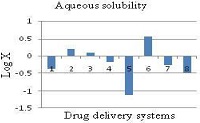Insilico modeling of chitosan as a drug delivery system
Keywords:
Drug delivery systems, chitosan, QSAR, quantum mechanical modelingAbstract
Computational modeling of polymeric nanoparticles as drug carriers have been extensively studied due to their varied functionalities, tunable structures and the capability of controlled drug release. Nano particulate polymeric drug delivery systems enable a cell specific targeting with negligible side effects and drug release based on change in physiological conditions. Eight common polymers are modeled and the various properties have been predicted. ADMET, QSAR, thermodynamic and electronic properties have been predicted and compared using SAR as well as quantum mechanical density functional methods. Comparison of the predicted properties suggests that chitosan, which is a natural polymer and has some advantages over others is a promising drug carrier candidate for tumor.
References
. Zhang et al. Design of Nanoparticles as Drug Carriers for Cancer Therapy.Cancer Genomics and Proteomics.2006; 3: 147–158.
. Agnieszka Z. Wilczewska et al. Nanoparticles as drug delivery systems.Pharmacol.Reports.2012; 64: 1020–1037.
. Mostafavi SH, Jayachandra Babu R. Nano-Sized Drug Delivery. J Mol Pharm Org. Process Res. 2013; 1(4): 1–2.
. Sanjeeb K Sahoo, VinodLabhasetwar. Nanoparticle Interface:An Important Determination Nanoparticle-Mediated Drug/ Gene Delivery. In: Nanoparticle Technology for drug delivery. New York:Taylor & Francis Group; 2006. p. 139-154.
. van de Waterbeemd H, Gifford E. Admet InSilico Modeling : Towards Prediction Paradise?. Nat Rev Drug Discov. 2003; 2(3): 192–204.
. Ramachandran KI, Deepa G, Krishnan Namboori PK. The Modeling of Molecules through Computational Methods. In: Computational Chemistry and Molecular Modeling- Principles and Applications. Germany: Springer International; 2008; p. 229-274.
. Malbouisson LAC et al. Optimization of Geometry at Hartree-Fock Level Using the Generalized Simulated Annealing. Applied mathematics.2012; 2: 1526-1531.
. Wang J, Hou T. Recent Advances on Aqueous Solubility Prediction. Comb Chem High Throughput Screen. 2011; 14(5):1-11.
. James L. McDonagh et al. Uniting Cheminformatics and Chemical Theory To Predict the Intrinsic Aqueous Solubility of Crystalline Drug like Molecules. J. Chem. Inf. Model. 2013; 54(3): 844-856.
. Kujawski J, Popielarska H, Myka A, Drabińska B, Bernard MK. The log P Parameter as a Molecular Descriptor in the Computer-aided Drug Design – an Overview. Comput. Methods Sci. Technol. 2012; 18(2): 81–88.
. Park JH, Saravanakumar G, Kim K, Kwon IC. Targeted delivery of low molecular drugs using chitosan and its derivatives. Adv. Drug Deliv. Rev. 2010; 62(1): 28–41.
. Kean T, Thanou M. Biodegradation, biodistribution and toxicity of chitosan. Adv Drug Deliv Rev. 2010; 62(1): 3–11.






